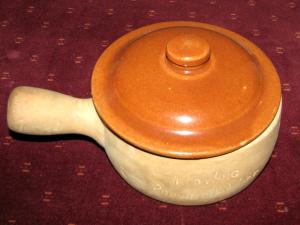There may be a RWCS Chapter near you
Learn more on our Chapters Page.
Membership is only $35 a year and includes six full-color newsletters and exclusive, members only, online content
Question:
 Hello, I inherited a Red Wing piece and would like to know more about it. It is a covered dish, with one handle and one pouring spout. The outside of the dish and the underside of the lid are unglazed. The inside of the dish and top side of the lid are glazed in a burnt orange type of color. The side of the dish is engraved: RED WING – PROVINCE (next to that is, I believe, your symbol. About 2" farther around the dish it is engraved with 2 2. I am including pictures. Would like to know the age, history, and worth. Thank you so much for your help. Sincerely, Karen Rosenkilde
Hello, I inherited a Red Wing piece and would like to know more about it. It is a covered dish, with one handle and one pouring spout. The outside of the dish and the underside of the lid are unglazed. The inside of the dish and top side of the lid are glazed in a burnt orange type of color. The side of the dish is engraved: RED WING – PROVINCE (next to that is, I believe, your symbol. About 2" farther around the dish it is engraved with 2 2. I am including pictures. Would like to know the age, history, and worth. Thank you so much for your help. Sincerely, Karen Rosenkilde
Answer: Your casserole is from the Provincial Cooking Ware line, made in the 1940s during the World War II years. The line included only baking pieces such as casseroles, stock or bean pots, marmites (individual size casserole), and open baking dishes. The exteriors are bisque (unglazed), the interiors and covers have a rust-colored glaze, and the sides are marked "Red Wing Provincial Cooking Ware" along with a stock number (on your piece, 22). The bisque exteriors were impossible to keep clean, and surviving pieces today usually have a very dirty appearance.
In the early 1960s Red Wing re-introduced this line as Provincial Bakeware. The new line retained the same pieces, shapes and rust-colored interiors and covers as the 1940s line. But there are two significant differences between the 1940s and the 1960s pieces. The newer line has a tan glaze on the exteriors, made to resemble the old bisque exteriors but much easier to clean. And the newer pieces are marked "RED WING USA" along with a stock number on the bottom rather than on the side.
The values for both the 1940s and 1960s versions are rather low as they include only baking items and thus don’t attract much interest from collectors, who generally prefer full dinnerware sets. Your casserole would be worth $10 to $25 if it is free from chips and cracks. The lower end represents the value of a typical stained pot, the upper end the value of a pot in clean, unstained condition.
Larry
